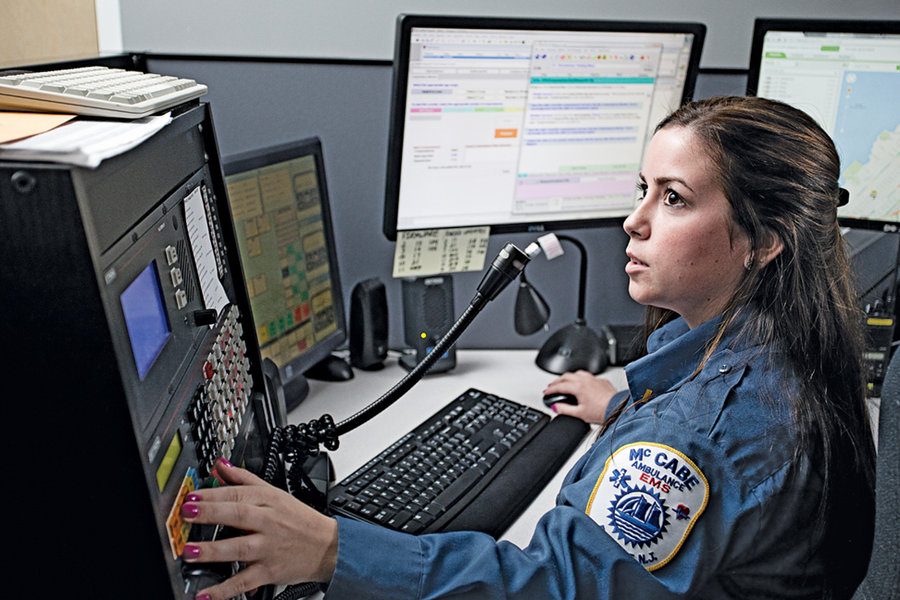When I walk into the McCabe Ambulance Service headquarters Michael McCabe says that unfortunately it’s a slow day. Unfortunate for me, fortunate for Bayonne residents who are not in a 911 emergency.
The service started as a mom-and-pop EMS, quite literally for Michael McCabe whose father, company president H. Mickey McCabe, founded the company. His mother, Judy, was an employee until her retirement six years ago.
The elder McCabe saw a need for a full-service EMS operation in Bayonne so he went to school and became an EMT.
The company was founded 43 years ago across the street from the current 41st Street location. The business was originally headquartered inside the McCabe home. A young Michael, who is now the Chief of Operations, grew up with an ambulance in his driveway.
“We still consider ourselves a family operation,” McCabe says, despite the fact that it is partially owned by Care Point Health, “We subscribe to that ideology of treating everyone like they’re your own family member.”
The company now has 50 vehicles and 140 employees, 75 of whom are Bayonne residents.
“We know everyone in Bayonne, fortunately and unfortunately,” McCabe laughs, “I will walk into 7-11 and someone will yell to me, ‘Mike, they didn’t give Grandma a blanket when they picked her up yesterday!’”
The company also does nonemergency transport, so it does get grandma comfortably to appointments.
All in a Day’s Work
McCabe introduces Deputy Chief Richard Krysick, my tour guide for the day. Krysick has been at McCabe for around 18 years, starting in transport and moving up to head of Critical Care. This sector brings patients with acute conditions from one facility to another with a registered nurse on board. Krysick later made Deputy Chief.
Our first stop is 911 dispatch, New Jersey’s only private dispatch center. Medical 911 calls made in Bayonne are routed there. A dispatcher views the address or cell phone GPS co-ordinates on a console near any of the 10 emergency lines. The 24/7 operation provides backup service to Hoboken and elsewhere when needed.
The dispatch room holds a multitude of large screens that display information and security footage of McCabe’s ambulance parking lots. GPS tracking tells them if a truck is around the corner from an emergency.
Dispatchers Casey McMahon and Frank Spina run through a sample call. The system uses question prompts to streamline the process during frantic phone calls. Spina reads the details that McMahon enters into the system and contacts the EMTs closest to our fake emergency.
Things Get Real
Two real 911 calls come in within moments of each other. Krysick whisks us out of the room. It’s time for our tour to move on.
Krysick pulls up in an SUV with the McCabe logo. The siren blares, and the radio crackles. Phrases like, “pedestrian struck” and “single vehicle” make my heart race as Krysick, running red lights, expertly navigates down JFK Boulevard.
We cover the two miles in under four minutes. The company boasts an average response time of less than five minutes, three faster than the state average. When we arrive, EMTs are already at work. Michael McCabe is there moments later.
Despite the chaos, and panic of the injured man, the McCabe team works calmly and swiftly. “It was a serious injury, but he’s going to be fine,” McCabe assures me.
The Right Stuff
What does it take to do what McCabe employees do?
“You have to be your best in the time that is their worst,” says McCabe. “It might be our ninth job of the day, but for them it’s their worst scenario. We look at ourselves as the third service; police, fire and EMS. It’s a smooth operation because we’re all tied in.”
Many McCabe employees go on to work as cops and firefighters. In fact, Cailin Brodel, Bayonne’s first woman firefighter, worked as a McCabe EMT for a few years. [See our cover story on page TK.]
“She cut her teeth doing this in emergency services,” McCabe says, describing Brodel as an incredibly driven go-getter.
The next stop is a parking lot on Avenue E and 21st Street that holds emergency vehicles. “These are for the what-if situations,” Krysick says, gesturing toward trucks, trailers, a full-size bus, and a miniature ATV ambulance.
The Big Stuff
The smaller vehicles are for maneuvering through crowds or rough terrain; the bigger ones are for dreaded large-scale emergencies.
“After 9/11, a lot of us weren’t prepared for the amount of people who needed help,” Krysick says. “After that the state, in conjunction with New York, put a waterfront strike team together, so that municipalities have all this mass equipment so you can be ready for hundreds of patients.”
I looked inside the Medical Ambulance Bus, or MAB, which is equipped to treat 24 patients, with bunk-bed-style gurneys and an oxygen system.
The MAB and other specialized units have seen action at multi-unit fires and in Sandy relief. It was used to evacuate Palisades Medical Center when a generator shut down. The trailers served as temporary shelter for EMTs, who handled 200 calls in six-hours.
“They’re there when you need them the most,” Krysick says of these resources. The same could be said for McCabe EMS and its team.—BLP
